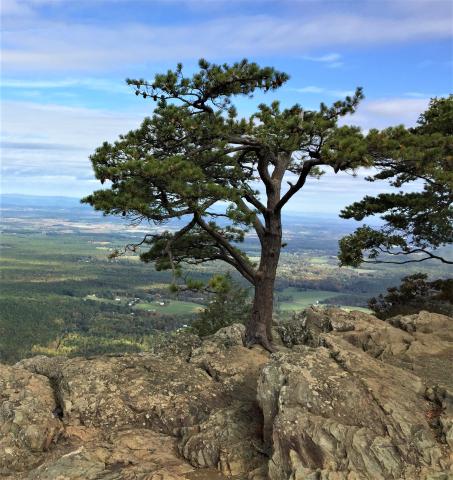Get to Know Our Local Pines
By: Steve Roark
Volunteer, Cumberland Gap National Historical Park
Pines can offer a dab of color in a winter landscape, and provide lumber, wildlife habitat, pleasing views, and erosion control. The native pines that grow in our area include Shortleaf, Virginia, Pitch, and White Pine. Though not a local native, Loblolly Pine has been widely planted and does well in our area.
Everybody knows a pine tree when they see it, but few can tell them apart. The easiest way is to look at the needles. They always grow in bundles, and by counting how many needles occur in each bundle (science guys call it a fascicle), you can determine the species. The form of the tree, the bark, and seed cone are other ways to figure out the species. Here's how you do it:
Virginia Pine has needles 2-3 inches long in bundles of 2 and have a bit of a twist to them. The trunk tends to hold onto a lot of dead branches, as well as old cones, which are 2-4 inches long with sharp prickles. The bark is dark and kind of shreddy. It’s not a particularly handsome tree.
Shortleaf pine has thin needles are 3-4 inches long and occur in bundles of mostly 2, but some in a 3 bundle. The cone is around two inches long and lacks prickles. The bark is brown and forms in large flat plates and are quite handsome to see.
Pitch Pine has needles are around 4-6 inches long in bundles of 3. The tree often has tufts of pine needles growing right out of the trunk. The cones have a round shape and around 3” in diameter. The bark is like shortleaf and forms in flat plates.
White Pine needles are a blue-green color and form in bundles of 5. The branches come off the trunk in distinct whorls like a wagon wheel. The cone is long and skinny and has no prickles.
Loblolly Pine has needles over 6 inches long in bundles of 3. The cone is oval and quite large, with prickles.
If the pine you're trying to identify is too tall to see the needles, look on the ground under the tree for the needle bundles. Cones can often be found there as well. Pines tend to grow on dry sites, such as south and west facing slopes, and ridge tops. Virginia Pine (also called old field pine) is very common on abandoned farmland. It is a pioneer species, meaning it is one of the first plants to move into disturbed areas.
While humans for paper, lumber, and hundreds of other products, wildlife utilizes pine trees for food and shelter. Several songbirds and squirrels feed on the seeds, and because pines are evergreen, they provide important shelter and cover, especially for protection from winter wind and snow, referred to as thermal shelter.
- Log in to post comments
